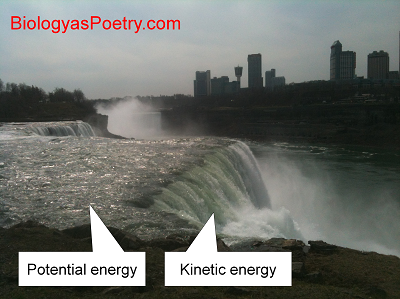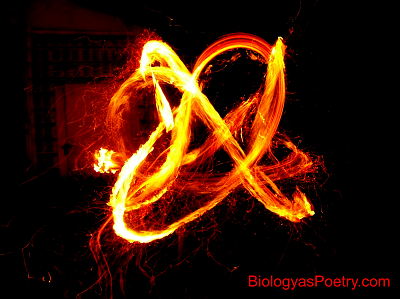∞ generated and posted on 2016.08.22 ∞
Ability to perform productive or operative activity, as manifest in the movement of material.
The faster something is moving, holding mass constant, or the greater its mass, holding velocity constant, then the greater the associated kinetic energy.
Similarly, potential energy that has been released, such as water flowing over falls, is as kinetic energy. That is, the water found above the falls, though moving, nonetheless is not moving terribly fast downward. Most of the impediments to its downward >motion are released upon passing over falls. The water as a consequence is greatly accelerated by gravity, converting potential energy to kinetic energy.

Figure legend: Water going over Niagara Falls represents kinetic energy – the energy of motion – whereas prior to the drop off, in comparison, the water represents potential energy. In fact, the Niagara Falls we know today can be quite diminished due to the harnessing of the kinetic energy associated with the Niagara River's passage through a series of pre-falls tunnels which are used to generate electricity. During tourist season, particularly during daylight hours, most of the Niagara River's water is allowed to flow over the falls, however.
The primary means by which energy enters into ecosystems is as photons. These photons possess a kinetic energy of sorts that is used by producers such as plants, eukaryotic algae, and cyanobacteria. In the course of the light reaction of photosynthesis, that light energy is used to increase the energy associated with electrons.
The electron-associated energy is then locked into chemical bonds. Chemical bonds subsequently are "broken" in course of catabolism – e.g., glycolysis and cellular respiration – to release that energy, ideally to do useful work.

Figure legend: Kinetic energy released in the course of burning of organic compounds, yielding water and carbon dioxide, as can occur within aerobic environments. The photograph is a one-second exposure taken at night of a flame that literally is in motion (as associated with a twelve-year-old boy, my son).>
The energy of heat, where heat consists of molecular motion, is in fact kinetic energy. The potential energy found in chemical bonds thus can be released as kinetic energy, whether as an explosion (clearly a form of kinetic energy!), simply the heating of surroundings, or something more refined/subtle, such as the catalytic activity of enzymes.
To view the following video you will need to click on it then follow the link to YouTube: